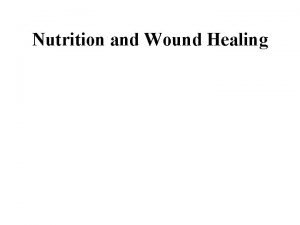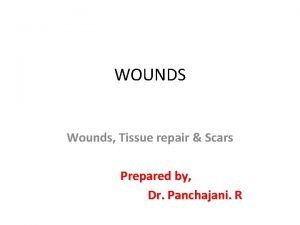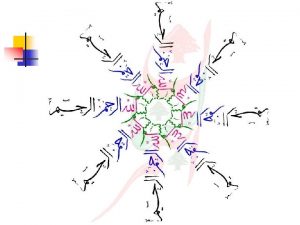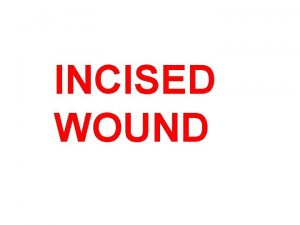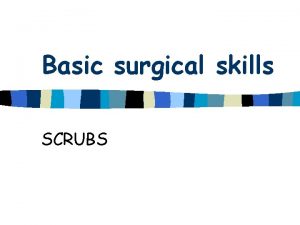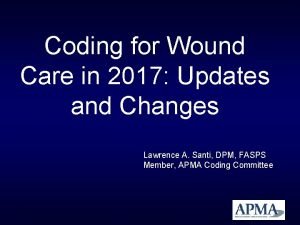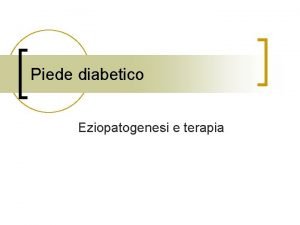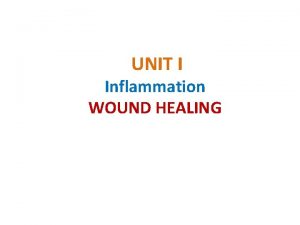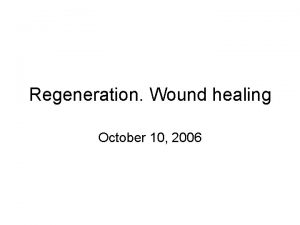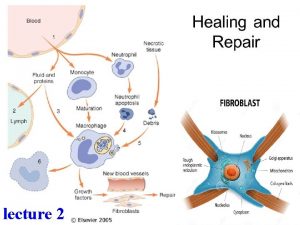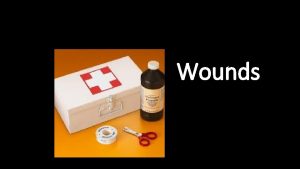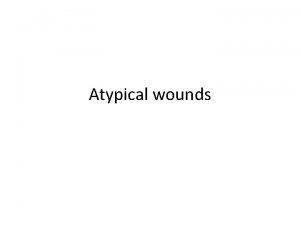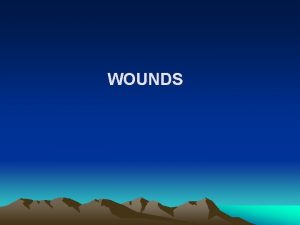Wound healing Classification of wounds Clean nontraumatic wounds











- Slides: 11

Wound healing

Classification of wounds Clean: non-traumatic wounds with no break in surgical technique, no septic focus, and no viscus opened (e. g. hernia repair) Clean-contaminated: non-traumatic wounds with contaminated entry into a viscus but with minimal spillage (e. g. elective cholecystectomy)

Contaminated: clean, traumatic wounds, or significant spillage from a viscus, or acute inflammation (e. g. emergency appendicectomy) n Dirty: includes traumatic wounds from a dirty source, or when significant bacterial contamination or release of pus is encountered n

General principles of healing Tissue healing in any organ follows some basic principles. n Cells may be labile (good capacity to regenerate, e. g. surface epithelial cells), stable (capacity to regenerate slowly, e. g. hepatocytes), or permanent (no capacity to regenerate, e. g. nerve and striated muscle cells). n Tissue architecture is important: complex arrangements cannot be reconstructed if destroyed, e. g. renal glomeruli. n Complete restitution occurs when part of a labile population of cells is damaged, e. g. a minor skin abrasion.

Granulation tissue is the combination of capillary loops and myofibroblasts. This is unrelated to a granuloma n Organization is the process where specialized tissues are repaired by formation of mature connective tissue, e. g. pneumonia or infarcts. n Wound contraction mediated by myofibroblasts can reduce the tissue defect by up to 80%, but can lead to problems, e. g. burns, contractures. n Collagen is secreted at the same time to form a scar. n

four stages of wound healing n n Haemostasis: immediate. In response to exposed collagen, platelets aggregate at the wound and degranulate, releasing inflammatory mediators. Clotting and complement cascades activated. Thrombus formation and reactive vasospasm achieve haemostasis Inflammation: 0 -3 days. Vasodilatation and increased capillary permeability allow inflammatory cells to enter wound, and cause swelling. Neutrophils amplify inflammatory response by release of cytokines; reduce infection by bacterial killing; and debride damaged tissue. Macrophages follow and secrete cytokines, growth factors, and collagenases. They phagocytose bacteria and dead tissue and orchestrate fibroblast migration, proliferation, and collagen production

n Proliferation: 3 days-3 weeks. Fibroblasts migrate into the wound and synthesize collagen. Specialized myofibroblasts containing actin cause wound contraction. Angiogenesis is stimulated by hypoxia and cytokines and granulation tissue forms n Remodelling: 3 weeks-1 year. Reorientation and maturation of collagen fibres increases wound strength.

Factors affecting wound healing n n n n Impaired arterial supply or venous drainage (global or local). Excessive movement, local distension, or distal obstruction. Infection, malignancy, foreign body, necrotic tissue, smoking. Malnutrition: obesity, recent weight loss, nutrient deficiency. Immunosuppressive: cancer, steroids, immunosuppressants, HIV. Anticancer therapies: radiotherapy and chemotherapy. Metabolic: diabetes, jaundice, uraemia, musculoskeletal diseases, age.

Wound healing in specific tissues n n n n n Skin: first intention healing This takes place where there is close apposition of clean wound edges. Thrombosis in cut blood vessels prevents haematoma formation. Coagulated blood forms a surface scab that keeps the wound clean. Fibrin precipitates to form a weak framework between the two edges. Capillaries proliferate to bridge the gap. Fibroblasts secrete collagen into the fibrin network. Basal epidermal cells bridge the gap and are eventually resorbed. The elastic network in the dermis cannot be replaced.

Skin: second intention healing This takes place in wounds where skin edges cannot be cleanly apposed. There is phagocytosis to remove debris. Granulation tissue to fill in defects. Epithelial regeneration covers the surface n

n Gastrointestinal tract Erosion is loss of part of the thickness of the mucosa. n n Adjacent epithelial cells proliferate to regenerate the mucosa. Healing may take place this way in a matter of hours. Ulceration is loss of the full thickness of the mucosa. n n n n Mucosa is replaced from the margins. The muscularis propria cannot be regenerated: it is replaced by scar. Damaged blood vessels bleed; fibrin covers the raw surfaces. Macrophages migrate in and phagocytose dead tissue. Granulation tissue is produced in the base. If the cause persists the ulcer becomes chronic. Fibrous scar tissue may result in contractions
 Local factors influencing wound healing
Local factors influencing wound healing Wound healing nutrition handout
Wound healing nutrition handout Chronic inflammation
Chronic inflammation Rank and wakefield classification
Rank and wakefield classification Factors affecting wound healing ppt
Factors affecting wound healing ppt Concealed stab wound
Concealed stab wound Primary union wound healing
Primary union wound healing Clean incised wound heals by
Clean incised wound heals by Clean up everybody let's clean up
Clean up everybody let's clean up Wound classification surgery
Wound classification surgery Utsa wound classification
Utsa wound classification University of texas wound classification system
University of texas wound classification system

